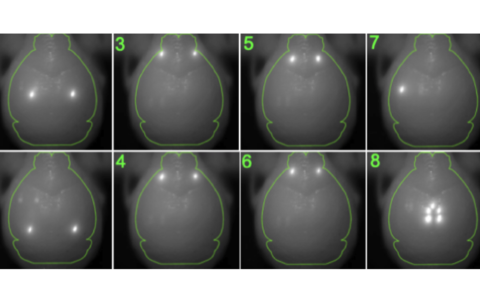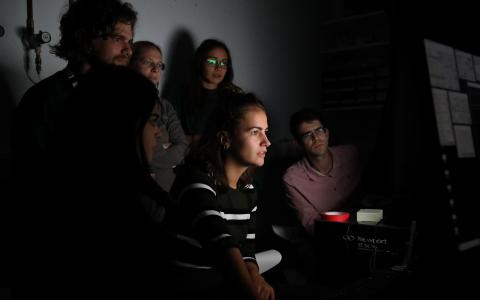
How does space travel impact astronauts’ kidneys? SWC Advanced Microscopy team aids new study
By April Cashin-Garbutt
In a pioneering study that bridges the realms of space exploration and biomedical science, a UCL-led team of researchers embarked upon a mission to understand the effects of space travel on kidney health. Their results, recently published in Nature Communications, reveal that space flight significantly alters kidney structure and function, with space radiation inflicting permanent damage that could jeopardise any mission to Mars. The SWC Advanced Microscopy team played a pivotal role in this research, providing cutting-edge imaging techniques that were crucial to the study’s success.
The challenges of space travel
Space travel presents a unique set of challenges to human health. Astronauts are known to be at a much higher risk of kidney stones and it is thought that microgravity and Galactic Cosmic Radiation (GCR) may cause fluid shifts and damage to subcellular structures called mitochondria, which are vital to kidney function. Funded by the UK Space Agency, Kidney Research UK and Wellcome Trust, the UCL-led study aimed to investigate these effects using a combination of historical NASA data, tissue samples from humans and animals in low Earth orbit, and animals exposed to simulated GCR.
Advanced imaging and big data
The SWC Advanced Microscopy team employed a variety of sophisticated techniques to analyse the kidney tissues. These included RNAScope for subcellular localisation of microRNAs (miRNAs), optical clearing for 3D imaging of large volumes of kidney tissue, and whole slide imaging (in confocal and brightfield) for digital histopathology. This comprehensive approach allowed the researchers to visualise the intricate changes occurring in the kidneys at a cellular level.
“We had to do a lot of planning to allow us to process the number of samples needed for the study. The slide scanner at SWC was a blessing as it allowed us to image up to 100 slides at a time,” explained Jessica Broni-Tabi, Histology Research Scientist at SWC.
“I am currently in the process of uploading terabytes of this data to NASA’s Open Science Data Repository and this will be the largest dump of imaging data they have ever received,” commented Dr Keith Siew, first author on the paper from the London Tubular Centre, based at the UCL Department of Renal Medicine.
Uncovering the effects of microgravity and GCR
The imaging work by the Advanced Microscopy team at SWC led to one of the key findings of the study: both human and animal kidneys are remodelled by microgravity.
“We found strong evidence that microgravity causes remodelling of the kidneys and that the kidney stones that astronauts experience might be in part due to primary kidney changes rather than solely microgravity-induced bone loss as was previously thought,” explained Professor Stephen Ben Walsh, corresponding author on the paper from the London Tubular Centre, UCL Department of Renal Medicine.
In addition to microgravity, the study also explored the impact of GCR on kidney health. The team looked at animals that had been exposed to acute doses of simulated GCR, equivalent to 1.5 year and 2.5 year Mars missions.
“We found lots of signals that were compatible with mitochondrial damage. Spatial transcriptomics also showed damage in two areas of the nephrons [functional units] that make up the kidney that are particularly reliant on mitochondrial respiration: the proximal tubule and loop of Henle,” explained Professor Walsh.
“Not only did the miRNA signals that Jessica detected with RNAScope corroborate this tubular damage, but her work also indicated endothelial damage in the capillaries was particularly evident in the kidney of GCR exposed mice. And then semi-automated digital histopathology showed that this damage was causing some of the mice to develop little blood clots in their glomeruli that would clog them up and ultimately cause scarring of nephrons,” Dr Siew added.
Thanks to the work of the SWC, the team were even able to investigate animals that had been given novel drug treatments to try to protect their kidneys against damage mediated by these miRNAs. Findings they intend to publish in a follow-up study to this work.
Collaborative efforts and future directions
Looking ahead, the team plan to keep collaborating to further explore the effects of space travel on the kidneys. In future work, they hope to map the nervous system in the kidney and conduct comparative anatomy studies with other animal species. They are also looking into ultra-rare cancers that may be caused by arsenic exposure.
“The SWC Advanced Microscopy Facility is focused towards high-throughput imaging of mouse and rat brains, and supporting in vivo neuroscience imaging needs. I’m keen to take on interesting projects outside our speciality when time allows. This is a great use of resources, it adds variety and broadens our technical horizons. The success of this study is a testament to our talented team, and I’m really proud of them,” said Rob Campbell, Head of Advanced Microscopy Facility at SWC.
“There is so much that the Advanced Microscopy Facility at SWC can do, and the team are incredibly talented. It has been so helpful engaging with them and talking about what’s possible with the newest and latest technologies or brainstorming on how to apply old techniques in innovative ways to address problems in new ways. There is so much potential!” concluded Dr Siew.
Find out more
- Read the paper in Nature Communications, ‘Cosmic kidney disease: an integrated pan-omic, physiological and morphological study into spaceflight-induced renal dysfunction’ DOI: 10.1038/s41467-024-49212-1
- Read the UCL news, ‘Would astronauts’ kidneys survive a roundtrip to Mars?’
- Access NASA OSDR GeneLab, Biospecimen Sharing Program (BSP) and NASA Biological Institutional Scientific Collection (NBISC)
- Learn more about the SWC Advanced Microscopy Facility
Image and videos
- Banner image: 3D imaging of a ground control mouse kidney (left) and a spaceflight mouse kidney (right). Credit: Chutong Zhong, Zhongwang Li, Peter Gordon, Keith Siew.
- Videos 1 and 2: Siew K et al. Cosmic kidney disease: an integrated pan-omic, physiological and morphological study into spaceflight-induced renal dysfunction. Nat Commun 15, 4923 (2024). Is licensed under CC BY 4.0. Available at https://doi.org/10.1038/s41467-024-49212-1
Supplementary Movie 1: Gross kidney morphology in 3D SHIELD-preserved kidneys from RR-10 spaceflight-exposed mice (28 days) were optically cleared (delipidated and refractive index matched). Presented are representative 3D video renders of mesoSPIM lightsheet 488-nm stimulated autofluorescence images of an exemplar ground control (left) and spaceflight (right) sample. Initially these are displayed as mean intensity gradient projections pseudocoloured with a heatmap, these later transition into a grayscale absorption opacity model as an alternative visualisation of structures. Some artefacts (e.g. tissue splitting) due to mechanical damage sustained during post-mortem dissections are visible in both samples.
Supplementary Movie 2: Kidney nephron morphology viewed in the XY through Zslices SHIELD-preserved kidneys from RR-10 spaceflight-exposed mice (28 days) were optically cleared (delipidated and refractive index matched). Presented are representative 2D Z-stacks of mesoSPIM lightsheet 488-nm stimulated autofluorescence images of an exemplar ground control and spaceflight sample. Some artefacts (e.g. tissue splitting) due to mechanical damage sustained during post-mortem dissections are visible in both samples.


